Salvador
da Bahia (Portuguese pronunciation: [sawvaˈdoʁ], Savior; historic name: São Salvador da Bahia de Todos os Santos, in
English: "Holy Savior of All Saints' Bay") is a largest-city on the
northeast coast of Brazil and the capital of the Northeastern Brazilian state
of Bahia. Salvador is also known as Brazil's capital of happiness due to its
easygoing population and countless popular outdoor parties, including its
street carnival. The first colonial capital of Brazil, the city is one of the
oldest in the country and in the New World. For a long time, it was simply
known as Bahia, and appears under that name (or as Salvador da Bahia, Salvador
of Bahia so as to differentiate it from other Brazilian cities of the same
name) on many maps and books from before the mid-20th century. Salvador is the
third most populous Brazilian city, after São Paulo and Rio de Janeiro, and it
is the ninth most populous city in Latin America.
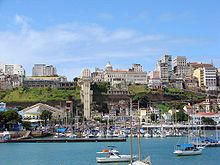
The
city of Salvador is notable in Brazil for its cuisine, music and architecture,
and its metropolitan area is the wealthiest in Brazil's Northeast, its poorest
region. Over 80% of the population of metropolitan region of Salvador has Black
African ancestry, the African influence in many cultural aspects of the city
makes it the center of Afro-Brazilian culture and this reflects in turn a
curious situation in which African-associated cultural practices are
celebrated, but Black Bahians due to their low income are apart from most of
the city life options. The historical center of Salvador, frequently called the
Pelourinho, is renowned for its Portuguese colonial architecture with
historical monuments dating from the 17th through the 19th centuries and has
been declared a World Heritage Site by UNESCO in 1985.
Salvador
is located on a small, roughly triangular peninsula that separates Todos os
Santos Bay from the open waters of the Atlantic Ocean. The bay, which gets its
name from having been discovered on All Saints' Day forms a natural harbor.
Salvador is a major export port, lying at the heart of the Recôncavo Baiano, a
rich agricultural and industrial region encompassing the northern portion of
coastal Bahia. The local terrain is diverse ranging from flat to rolling to
hills and low mountains.
A
particularly notable feature is the escarpment that divides Salvador into the
Cidade Alta ("Upper Town" - rest of the city) and the Cidade Baixa
("Lower Town" - northwest region of the city), the former some 85 m
(279 ft) above the latter,[1] with the city's cathedral and most administrative
buildings standing on the higher ground. An elevator (the first installed in
Brazil), known as Elevador Lacerda, has connected the two sections since 1873,
having since undergone several upgrades.
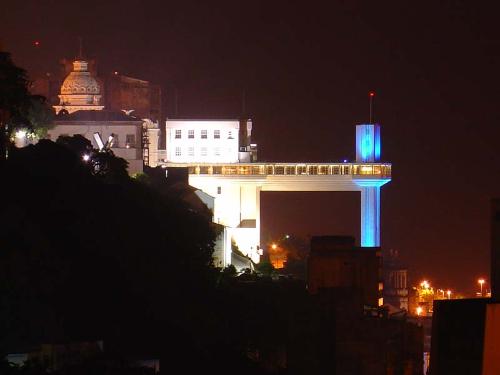
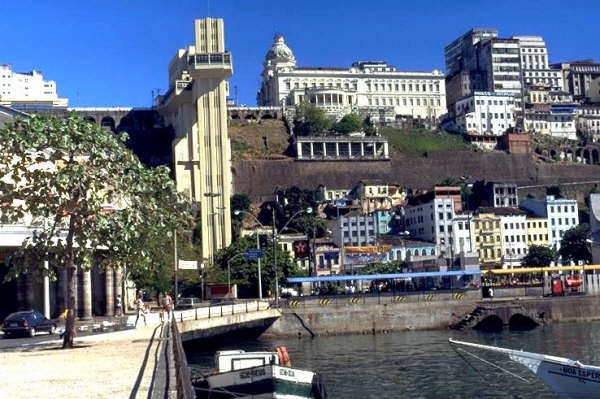
The
Deputado Luís Eduardo Magalhães International Airport connects Salvador with
Brazilian cities and also operates international flights, and the city is home
to the Federal University of Bahia.
History
Baía
de Todos os Santos (All Saints Bay) was first encountered by the Portuguese and
named in 1502. In 1501, one year after the arrival of Pedro Álvares Cabral's
fleet in Porto Seguro, Gaspar de Lemos arrived at Todos os Santos Bay and
sailed most of the Bahia coast. But the first European man to disembark on
"Morro de São Paulo," Saint Paul's Mount, was Martim Afonso de Sousa,
in 1531, leading an expedition to explore the coast of the new continent. In
1510, a ship, containing the Portuguese settler named Caramuru by the natives,
wrecked near the borough of Rio Vermelho. In 1534, Francisco Pereira Coutinho
founded a town near Barra borough, called Vila Velha, Portuguese for "Old
Village."
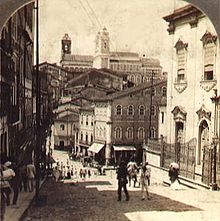
In
1549, a fleet of Portuguese settlers headed by Tomé de Sousa, the first
Governor-General of Brazil, established Salvador. Built on a high cliff
overlooking All Saints bay as the first colonial capital of colonial Brazil, it
quickly became its main sea port and an important center of the sugar industry
and the slave trade. Salvador was divided into an upper and a lower city, the
upper one being the administrative and religious area and where the majority of
the population lived. The lower city was the financial center, with a port and
market. In the late 19th Century, funiculars and an elevator, the Elevador
Lacerda, were built to link the two areas.
The
city became the seat of the first Catholic bishopric of Brazil in 1552, and is
still a center of Brazilian Catholicism. By 1583, there were 1,600 people
residing in the city, and it quickly grew into one of the largest cities in the
New World, surpassing any colonial American city at the time of the American
Revolution in 1776. Salvador was the capital city of the Portuguese viceroyalty
of Grão-Pará and its province of Bahia de Todos os Santos. The Dutch Republic
captured and sacked the city in May of 1624, and held it along with other north
east ports until it was retaken by a Spanish-Portuguese fleet in May 1625. It
then played a strategically vital role in the Portuguese-Brazilian resistance
against the Dutch.
Salvador
was the first capital of Brazil and remained so until 1763, when it was succeeded
by Rio de Janeiro. The city became a base for the Brazilian independence
movement and was attacked by Portuguese troops in 1812, before being liberated
on July 2, 1823. It settled into graceful decline over the next 150 years, out
of the mainstream of Brazilian industrialization. It remains, however, a
national cultural and tourist center. By 1948 the city had some 340,000 people,
and was already Brazil's fourth largest city. In 2008 was 2,948,733, the third
largest population of Brazil.
In
the 1990s, a major city project cleaned up and restored the old downtown area,
the Pelourinho, or Centro Historico ("Historical Center"). Now, the
Pelourinho is a cultural center, and the heart of Salvador's tourist trade.
Nonetheless, this social prophylaxis resulted in the forced removal of
thousands of working class residents to the city's periphery where they have
encountered significant economic hardship. Additionally, the Historical Center
is now something of a depopulated architectural jewel whose "animation"
must be brought in and sponsored by local shopowners and the Bahian state.
Similar situations may be found in many UNESCO World Heritage Sites today but
the Pelourinho, in light of Salvador's economic inequalities and ruling
governmental coalition's of the 1990s, seems to have gone farther than most in
sacrificing its population to the needs of tourist-based preservation.
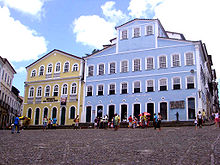
Salvador
has been the birthplace of many noted Brazilians, including musicians such as
song-writer Dorival Caymmi, Música Popular Brasileira (MPB or Brazilian Popular
Music) star Gal Costa, and Grammy Award winner Gilberto Gil. Gil later went on
to serve as a city council member (vereador) and is the Brazilian Minister of
Culture in the cabinet of President Luiz Inácio Lula da Silva. Also internationally
recognized are the city's Blocos Afros, such as Olodum, Ara Ketu, and Ilê Aiyê.
Notable writers associated with Salvador include Jorge Amado, considered one of
Brazil's greatest authors and fabulists, and João Ubaldo Ribeiro. The famous Brazilian
visual artist Carybé is based in Salvador as well. Celebrities born in Salvador
include supermodel Adriana Lima.
Salvador
features a tropical rainforest climate with no discernable dry season.
Temperatures are relatively constant throughout the course of the year,
featuring warm and humid conditions. Salvador’s driest month of the year is
February, where the city receives on average 11 cm of precipitation. Salvador’s
wettest months are between May and July where 21 cm of rain falls during these 
